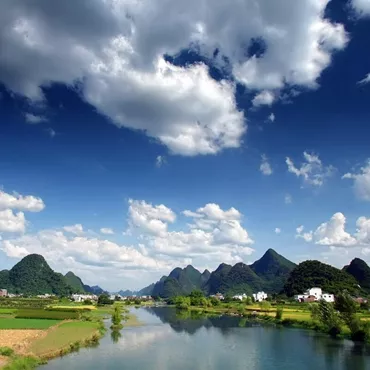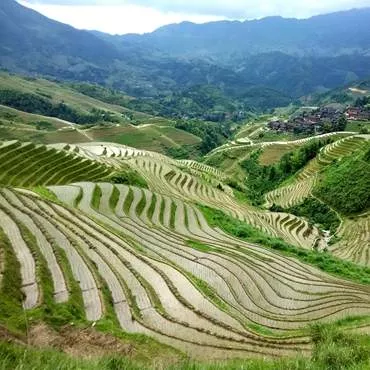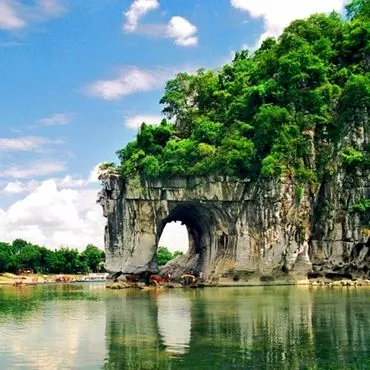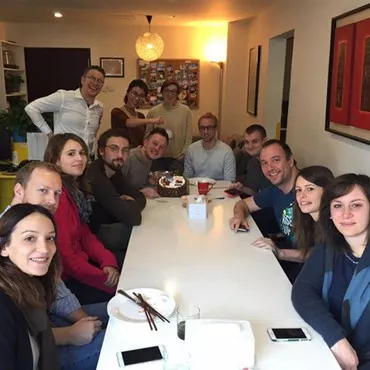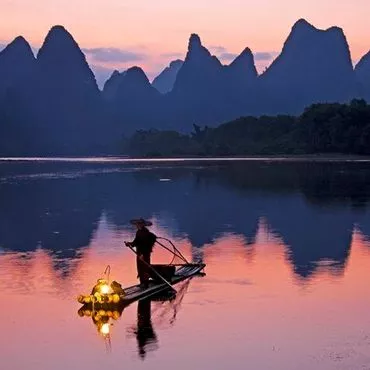Longji Ancient Zhuang Village
Longji Ancient Zhuang Village, officially known as Longji Village Committee of Longji Town, Longsheng County, encompasses four Zhuang natural village settlements: Liaojiazhai, Houjiazhai, Pingduan, and Pingzhai. Since the Yuan Dynasty, the ancestors began building villages here, constructing terraces on the mountainside and cultivating rice paddies that wind up from the foot of the mountain, creating a magnificent landscape of layered terraces stretching for miles.
In 2010, the Longji Zhuang Ecological Museum was completed, recognized as one of the first five demonstration points for ecological (community) museums nationwide. The "Three Fishes Sharing One Head" motif, Longji stone carvings, and stone steles are all protected cultural relics. The cultural heritage includes Northern Zhuang costumes, Northern Zhuang folk songs with two-part harmony, Longji rice wine, Longji terrace farming techniques, Longji rice culture, Zhuang ethnic shoulder pole dance, and Zhuang stilted wooden houses, all listed in the Intangible Cultural Heritage Protection List.
To this day, Longji preserves mountainous agricultural culture represented by terrace landscapes, architectural culture represented by stilted houses, stone culture represented by inscriptions and stone pathways, ethnic autonomy system culture represented by the "village elder" system, clothing culture represented by "white clothing," cuisine culture represented by the "Four Treasures of Longji" (rice wine, chili, glutinous rice, tea), and song and dance culture represented by curved songs (wange) and bronze drum dances.
Nestled in the heart of Longsheng County, Longji Ancient Zhuang Village is a testament to the harmony between human ingenuity and natural beauty. From its origins in the Yuan Dynasty to the present day, this picturesque landscape of terraced rice paddies cascading down the mountainsides has captured the imagination of visitors and scholars alike.
The journey through Longji is not merely a physical passage but a spiritual odyssey into the depths of Zhuang heritage. Each terrace tells a story of perseverance and innovation, where generations of Zhuang people have sculpted the land into a living tapestry of agricultural artistry. The terraces themselves, like giant steps ascending towards the heavens, evoke a sense of awe and wonder, their verdant tiers reflecting the changing seasons in a timeless dance of growth and harvest.
At the heart of Longji lies the spirit of community and cultural resilience. The Longji Zhuang Ecological Museum stands as a beacon of sustainable development, showcasing not only the ecological wealth of the region but also the profound connection between the Zhuang people and their natural environment. It serves as a sanctuary where visitors can immerse themselves in the traditions of rice cultivation and the intricate rituals that accompany each planting season, preserving ancient wisdom in a modern world.
Among the cultural treasures of Longji, the "Three Fishes Sharing One Head" symbolizes unity and harmony, reminding us of the Zhuang people's deep-rooted values of cooperation and mutual support. The stone carvings and steles, etched with tales of heroism and community triumph, bear witness to the enduring spirit of Longji's inhabitants, who have safeguarded their cultural heritage amidst the passage of time.
The architecture of Longji is a testament to human ingenuity in harmony with nature. The stilted wooden houses, with their intricate designs and practical adaptations to the mountainous terrain, exemplify the Zhuang people's intimate understanding of their surroundings. These houses not only provide shelter but also serve as symbols of cultural identity, where each beam and column tells a story of craftsmanship passed down through generations.
In the realm of cuisine, Longji delights the senses with its "Four Treasures" — rice wine, chili, glutinous rice, and tea. Each ingredient reflects the bounty of the land and the culinary expertise of the Zhuang people, inviting visitors to savor the flavors of tradition preserved through centuries of cultivation and culinary innovation.
Music and dance form an integral part of Longji's cultural tapestry. The melodious strains of Northern Zhuang folk songs resonate through the terraced valleys, their two-part harmonies weaving tales of love, resilience, and ancestral wisdom. The Zhuang shoulder pole dance, a graceful expression of community celebration, embodies the spirit of unity and collective joy that defines life in Longji.
As visitors traverse the stone pathways adorned with ancient inscriptions, they are transported back in time to an era where communication was etched in stone. These pathways, once the lifeline of village connectivity, now serve as conduits of cultural transmission, preserving the written word and communal history for future generations to behold.
The attire of the Zhuang people, characterized by "white clothing," is more than a mere garment; it is a symbol of cultural pride and identity. Each intricate stitch and pattern carries with it the stories of ancestral craftsmanship and aesthetic sensibility, reflecting the Zhuang people's deep reverence for tradition and heritage.
In conclusion, Longji Ancient Zhuang Village stands as a testament to the enduring legacy of the Zhuang people's cultural heritage. From its breathtaking terraced landscapes to its vibrant traditions of music, dance, and cuisine, Longji encapsulates the essence of harmony between humanity and nature. It is a place where the past meets the present, where cultural resilience meets environmental stewardship, and where every visitor is invited to embark on a journey of discovery and appreciation for the rich tapestry of Zhuang culture.

